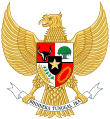Villages in Indonesia
| This article is part of a series on the |
| Politics of Indonesia |
|---|
 |
| This article is part of a series on |
| Subdivisions of Indonesia |
|---|
| Level 1 |
|
| Level 2 |
|
| Level 3 |
| (kecamatan, distrik, kapanewon, or kemantren) |
| Level 4 |
| (desa or kelurahan) |
| Others |
An administrative village (Indonesian: kelurahan, desa) is the lowest level of government administration in Indonesia. It could be a village or a kelurahan. A village is headed by a village chief (kepala desa), which is elected by popular vote. A kelurahan is headed by a lurah, a civil servant appointed by local government (city or regency). A village is divided non-administratively into local communities which manage certain number of households. In Aceh, a village is called as gampong. Since the implementation of regional autonomy in 2001, the larger nagari has been introduced in place of the desa as the lowest government unit in West Sumatra.[1]
Village is the lowest level of government administration in Indonesia. Furthermore, a village is divided into several community groups (Rukun-Warga (RW)) which are further divided into neighbourhood groups (Rukun-Tetangga (RT)). In Java the desa (village) is divided further into smaller units called dusun or dukuh (hamlets), these units are the same as Rukun-Warga.
Notes
- ^ Franz and Keebet von Benda-Beckmann, "Recentralization and Decentralization in West Sumatra," in Holtzappel and Ramstedt (eds.), Decentralization and Regional Autonomy in Indonesia: Implementation and Challenges, Singapore and Leiden, 2009, pp. 233ff. at 302. Ardimas Sasdi, "West Sumatra reinvents its original roots," The Jakarta Post, 25 January 2008.
